ZF ready to ramp up production of e-Mobility drivetrain components and solutions in 2025
By Jim Gibbins - 11th April 2024
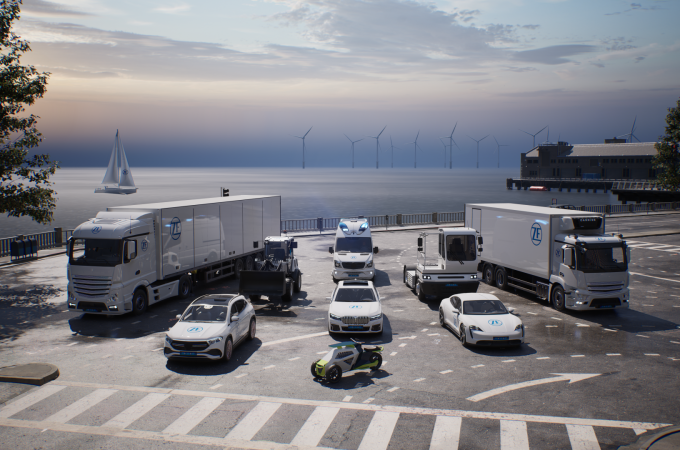
Range of vehicles to which ZF Group supplies e-Mobility solutions
Germany - Having announced its ‘E-Mobility kit’ in 2023 - a next-generation suite of electric drives, auxiliary components and complete systems for medium- and heavy-duty commercial vehicles – ZF Group of Friedrichshafen, Germany, says it plans to start ramping up production from 2025 to meet demand.
The ZF Group states that with no single zero-emissions powertrain solution able to provide the full range of capabilities of a traditional diesel-powered vehicle, such as range and rapid refuelling, the immediate future for commercial vehicles will involve a combination of technologies, with battery electric and fuel cell drives leading the way in the field of electrification.
Explaining the logic behind this strategy, Dr Andreas Grossl, who leads the global product segment of electric drives for CVs at ZF says: “We foresee a mix of powerline technologies, depending on the type of application the vehicle will be used for. Our E-Mobility kit is modular in nature, which is important for a global supplier like ZF, where we see different technologies developing rapidly. In the coming years, batteries as well as fuel cell applications will come to the market to deliver decarbonization. Both our next generation platforms, CeTrax 2 and AxTrax 2, have been designed so that they can either use batteries or fuel cells as their power source.”
So, what is ZF’s E-Mobility kit?
ZF’s E-Mobility kit is a suite of modular components that are combined to create and deliver a mixture of electric drivelines for commercial vehicles. The diagram below shows its suite of five driveline solutions (AxTrax 2, AxTrax 2 Dual, CeTrax 2, CeTrax 2 Dual and AxTrax 2 LF (low floor)) for medium and heavy-duty commercial vehicles built using a mixed selection of five ZF in-house developed modular core components (e-Motor, Inverter, Transmission, e-Actuators and Electronic Control Units (ECU)) – see diagram below.
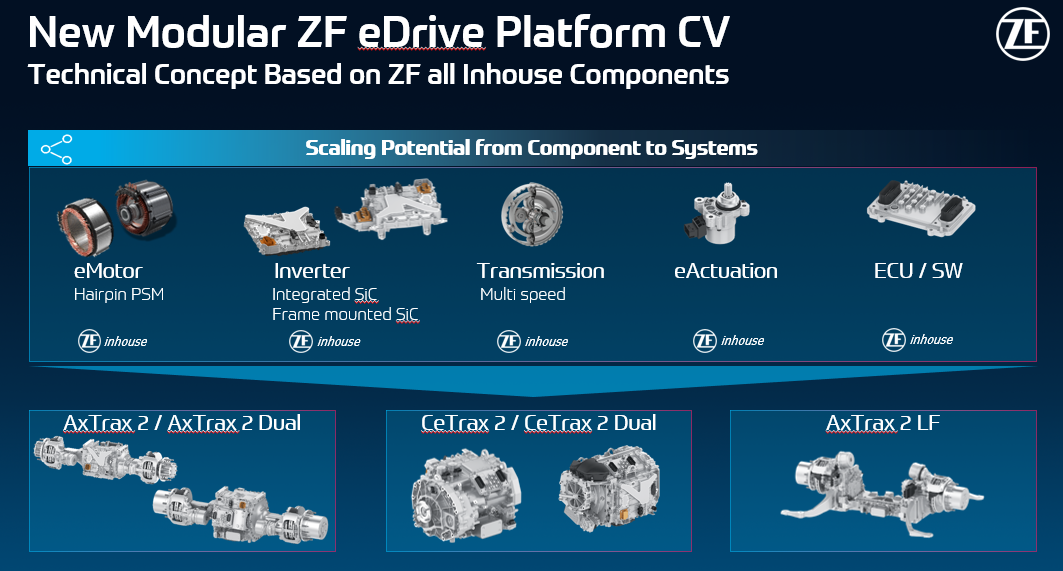
ZF’s E-Mobility kit
Development of these components and drive systems, of course, has not happened overnight. ZF, over the past 30 years has made significant financial investments to develop advanced components for electric mobility through a mix of in-house innovation and strategic acquisitions (TRW & WABCO for example) and alliances / partnerships (NVIDIA & Mobileye for example).
ZF says that building up a production process capable of manufacturing a range of different drives presents a big challenge for OEMs to manage and this is why it has taken a modular approach in developing its E-Mobility kit.
The company explains that ZF’s kit includes a central drive platform – the CeTrax 2 – which can slot into the same space as a conventional transmission, as well as an axle drive platform – the AxTrax 2. This means that all five drive systems (AxTrax 2, AxTrax 2 Dual, CeTrax 2, CeTrax 2 Dual and AxTrax 2 LF) are equipped with one of only two electric motor variants and just one inverter. Furthermore, the electric actuator and the electronic control unit, including the software, are also used uniformly across all drive systems.
By using scalable and modular componentry, ZF states this saves development resources and enables economies of scale in production to help manage costs.
Next generation of ZF heavy-duty drivelines launched
AxTrax 2 LF1 - 2023 saw ZF introduce to the markets of Europe, North America and China the latest next generation driveline systems. Most recently, the AxTrax 2 LF for city buses was launched in Europe and North America at Busworld and APTA shows, respectively.
The AxTrax 2 LF is available in two power variants, offering continuous power outputs of 260 kW and 360 kW and peak torques of 22,700 Nm and 37,300 Nm. With the more powerful variant, it is possible to achieve a 20% climbing ability even for articulated buses of up to 29 tons with one driven axle. Articulated and double-articulated buses can also be equipped with two electric low-floor axles to help improving traction on slippery and icy roads.
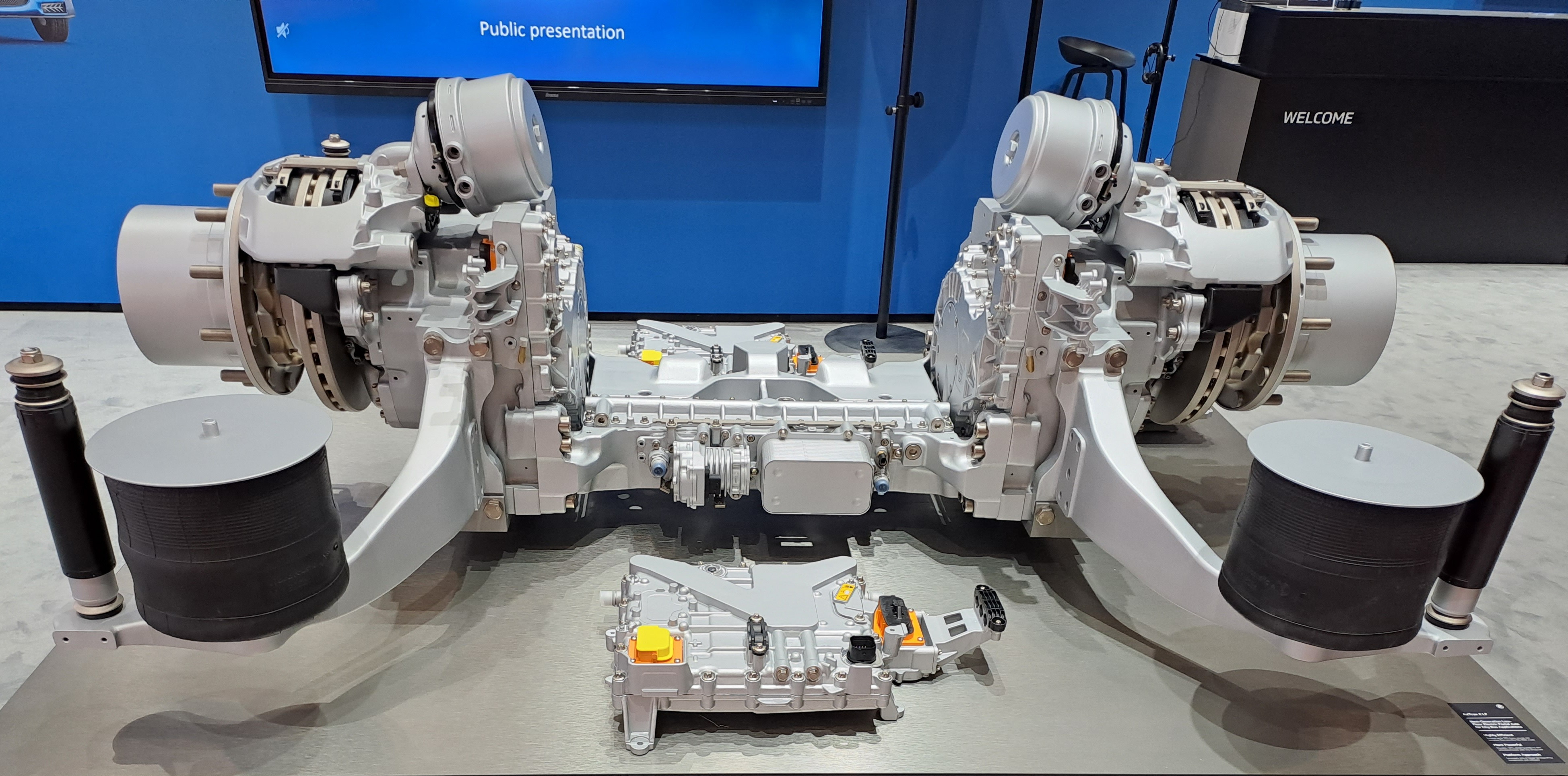
AxTrax2_LF with inverter
AxTrax 22 - At Advanced Clean Transportation (ACT) Expo in Anaheim, California, held between May 1-4, 2023, ZF launched a new electric axle drive system for the global Class 5-8 commercial vehicle market, AxTrax 2.
AxTrax 2 maximizes the available space for cargo or the passenger cabin as well as for batteries and enhances the manufacturer’s design flexibility for future vehicle concepts. The electric drives can be fully synchronized with key vehicle functions, such as braking, ADAS and automated driving systems, to help enhance vehicle safety and efficiency. It also enables advanced digital and telematics systems to exchange information with the e-axle via CAN bus.
AxTrax 2 is offered in two power variants. The AxTrax 2 for commercial vehicles enables a continuous power of 210 kW, while the AxTrax 2 dual variant includes two integrated e-motors and is ideal for heavy-duty applications and offers 380 kW continuous power.
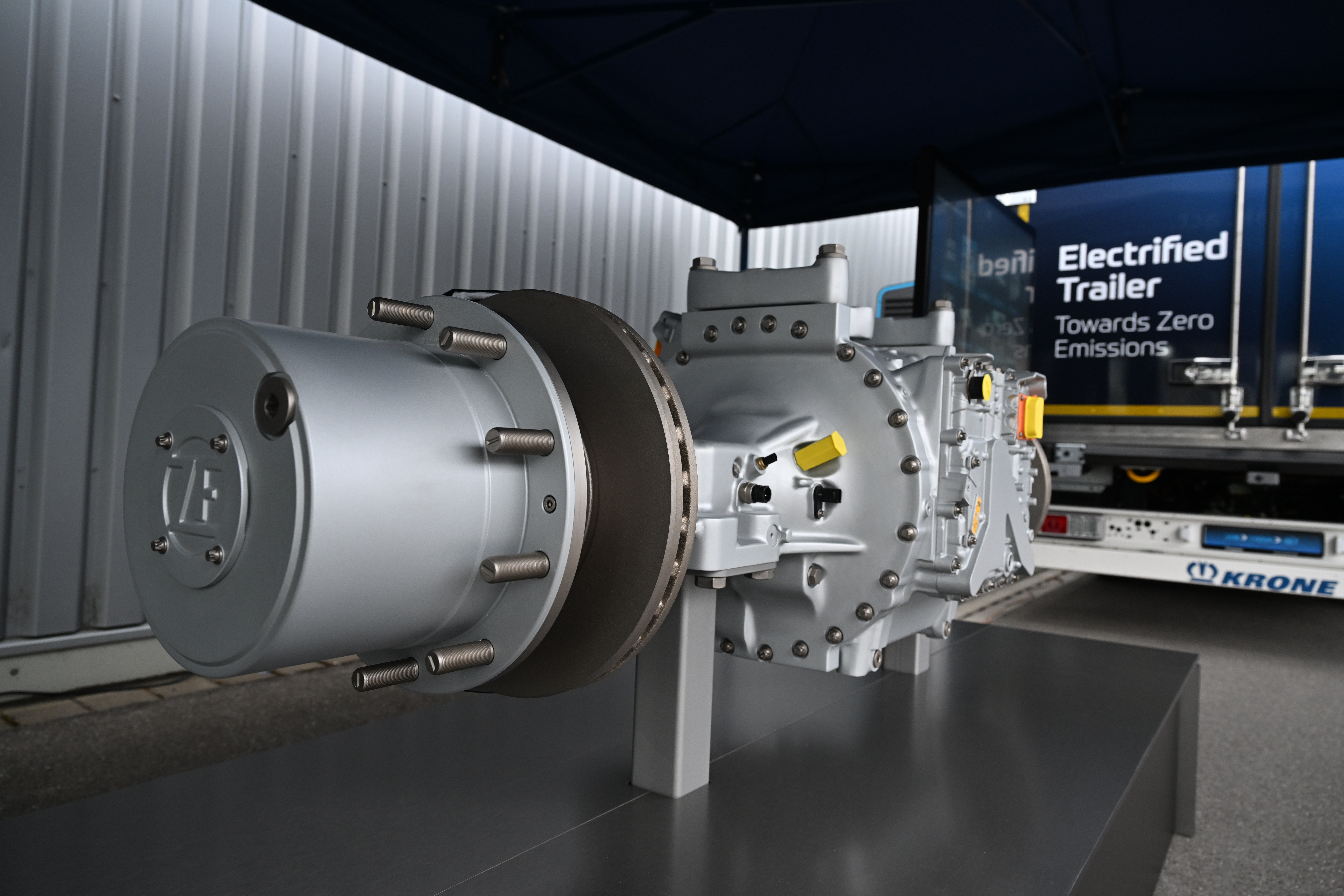
AxTrax 2
CeTrax 23 - At the IAA in 2022, ZF unveiled its new electric drive system, the ‘CeTrax 2’, which is to succeed the original CeTrax that entered production in 2020. The CeTrax 2 comprises two hairpin electric motors, two 800V silicon carbide inverters and a 3-speed gearbox in a single unit. Series production of the CeTrax 2 is slated for this year, with DAF Trucks in Eindhoven being the first customer to be officially announced.
Thanks to the plug-and-play design approach, CeTrax 2 electric drives can be easily integrated into existing vehicle concepts, by fitting within the space of the transmission of an ICE vehicle. The system integrates modular and in-house developed components which results in an innovative integrated solution enabling compact size and light weight.
The CeTrax 2 is offered in two variants, the CeTrax 2 has a continuous power of 210 kW, while the CeTrax 2 dual version has 380 kW and is suitable for vehicles up to 44 tons. CeTrax 2 dual’s electric central drive is actioned with smooth and almost imperceptible gear changes due to its seamless powershifting.
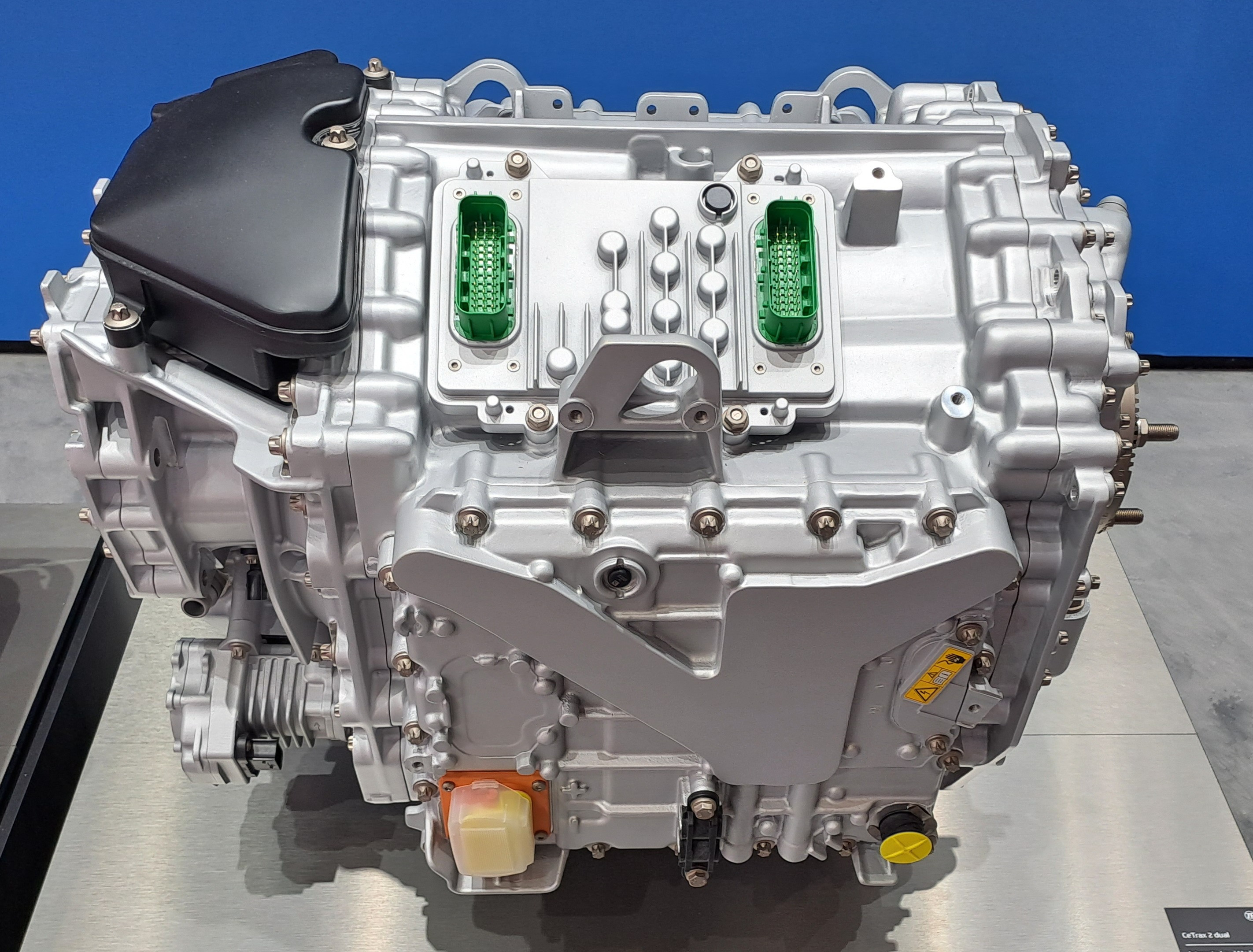
CeTrax2Dual electric central drive
ZF's CV division benefits from e-component advancements in passenger car
‘Migrating technologies from one vehicle type to another is something that ZF excels at, thanks to its strong presence in developing passenger car technologies,’ states ZF. ‘We can adapt these technologies to the more demanding and varied applications of commercial vehicles.’
Reaffirming these statements, Grossl says: “We can take our experience from the PassCar side of the business to develop solutions for CVs.” Grossl adds: “The time from design-concept to market is shorter for cars, whereas commercial vehicles have longer life cycles. For example, we are now starting to produce drivetrain systems that use permanent magnet synchronous motors (PMSMs), a technology that we have been producing for PassCars for years.”
Commenting further on the group’s ability to produce electric components in volume for the passenger car segment, Grossl says: “We have the opportunity to push further and faster on electrification, bringing innovations such as hairpin technologies* from PassCar to commercial vehicles and produce them at a much higher scale.” (Grossl’s reference to the use of hairpin technologies is important in CV applications because less copper is used in the stator winding with many benefits such as material saving, reduced size, reduced weight, as well as low noise).
Grossl says that its electronic systems and software also play a key role in ensuring commercial vehicles function optimally, regardless of what is powering them. “Our new EST 90 ECU (electronic control unit) interconnects all these systems and controls the optimal interaction,” Grossl explains. “It possesses three-times the computing power and four-times the memory compared to the previous generation. It operates the invertors and the actuators for the CeTrax 2 instead of pneumatic technology.”
Assembly of e-drive systems
Since 2022, a dedicated “eMobility Campus” has been in the process of being created at the ZF Group’s headquarters and transmission primary gear production plant in Friedrichshafen. The clearing of the demarcated area, extending to some 2,000 square metres is expected to be completed by the end of this year in readiness to conduct series assembly of its future electric drive systems, i.e. the ramp up of the CeTrax and AxTrax models in 2025.
The company has also invested in new production facilities in China: As recently as July 2023, ZF started to construct its third e-mobility production plant for passenger cars and commercial vehicles under the ZF New Energy Vehicle eDrive Project. ZF has opened already two other e-mobility plants in China since 2021.
Global demand for electric drivetrains in the CV sector
ZF anticipates the global market for electrified commercial vehicles to grow in the coming years. For trucks weighing over 6 tons, projections indicate a growth rate of 17% from 2022 to 2030. For trucks exceeding 16 tons, ZF forecasts an increase of 19%. The driving forces behind this growth are primarily attributed to the robust demand emanating from China and then subsequently India.
The key driving force behind this demand lies in the regulatory environment, particularly concerning the tightening controls on CO2 emissions. Governments and regulatory bodies worldwide are increasingly imposing stringent measures to curb emissions from commercial vehicles, thereby steering the industry towards decarbonised technologies.
In Europe, initiatives aimed at reducing CO2 emissions are becoming increasingly tighter, with targets ranging between 30% and 40% compared to 2019 levels. Strategies to achieve these targets include the implementation of increased toll charges and the expansion of low emissions zones in urban areas, encentivising operators to adopt cleaner vehicles.
Across the Atlantic in the United States, California’s Advanced Clean Truck Regulations, which sets out all buses and long-haul trucks to be ZEVs by 2045, is being adopted by a growing number of other states (16 by November 2023 including Washington DC). Additionally, measures such as the Inflation Reduction Act package are also set to provide added incentives to bolster demand further.
In China, policies such as the dual credit system which incentives OEMs in China to build fuel efficient vehicles, and the country’s target of establishing a fleet of 1 million fuel cell electric vehicles (FCEVs) by 2035, will also drive-up demand.
ZF says that electrification in China is already far ahead when it comes to electrifying city buses. In 2022, 86% of heavy city buses were already running on battery power, compared with 15% in Europe. ZF says that this is helping Chinese bus manufacturers gain a head start on their competitor OEMs, adding that Chinese bus builders have clear ambitions to make significant inroads into the global market, as seen by their strong showing at the recent Busworld trade show in Brussels demonstrated (see T&BB Busworld report).
ZF says: ‘Although city buses provide a highly visible marker of the transformation towards electrification, bus volumes are low compared with those of trucks. With electrified trucks – whether BEV or Fuel Cell powered – now becoming a viable alternative, supplier manufacturers, like ZF, are ramping up production, making electric drives more attractive, especially from a cost perspective.’


